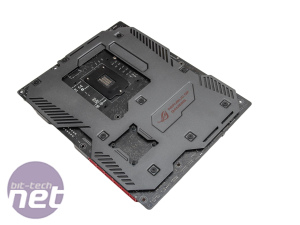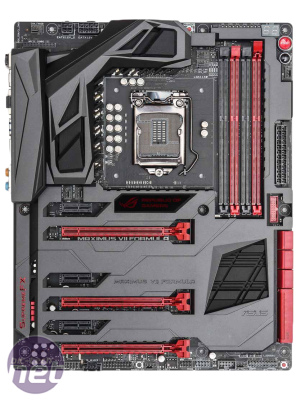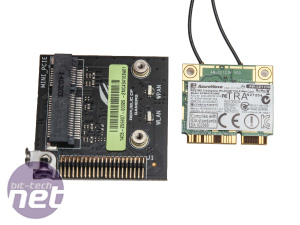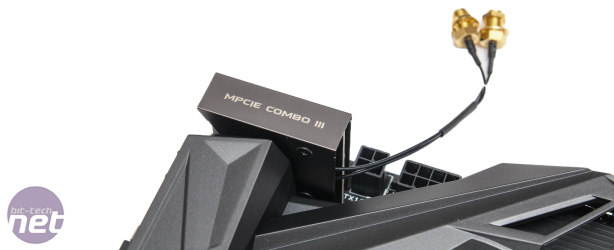
Layout and Expansion
The top graphics slot will see particularly long graphics cards overhang some of the SATA ports, but seeing as these are angled, this shouldn't be too much of an issue. Those plastic shrouds on the heatsinks do appear to bulk up the CPU socket area, but they rise lower than low profile memory, so shouldn't interfere with large CPU coolers.Click to enlarge
The CrossChill hybrid waterblock makes a return too, and is slightly beefed up compared to the one on the Maximus VI Formula, with a large copper insert to boost surface area, although this could potentially add restriction to water-cooling loops. As with its predecessor, Asus has made the smart move and ditched pre-fitted barbs in favour of G1/4in threads so you can use whatever fittings you like.
Click to enlarge
Click to enlarge
ROG armor makes a return too, and as well as the top cover, the rear steel backplate is equipped with thermal pads to aid cooling directly behind the VRMs. However, the front cover especially can make fitting the included mPCIe Combo III card very tricky.
Click to enlarge
One major issue to be aware of with the Combo III card is that the top VRM heatsink sits in the line of the M.2 slot. Even with the armour removed, only M.2 SSDs of type 2260 (60mm) or smaller will fit. Sadly, the vast majority of M.2 SSDs are 2280 (80mm), including our test model - Plextor's PX-G256M6e. As such we were unable to get M.2 results. We're fairly sure every M.2-compatible board we've looked at so far can support type 2280 M.2 SSDs and given they're likely be a popular option to get faster-than-SATA 6Gbps speeds, the Maximus VII Formula is at a disadvantage here. Another 20mm would have made all the difference, as would mounting the M.2 port on the PCB separately.
Click to enlarge
The Maximus VII Formula looks good with or without its armour, but the fact it's easily removable means that for modders who want to crack open the paint tin or extreme overclockers who will likely coat the board in putty ready for some LN2 fun, this should make things easier.
Click to enlarge
The mPCIe Combo III module is fairly compact but, as we mentioned above, it's limited by the heatsinks in terms of the length of M.2 SSDs it can support. There's also no securing screw either, with the SSD simply held in place by two foam pads. However, the addition of 802.11ac dual-band WiFi is a welcome one, so long as you have a compatible router that is.
Click to enlarge

MSI MPG Velox 100R Chassis Review
October 14 2021 | 15:04




















Want to comment? Please log in.